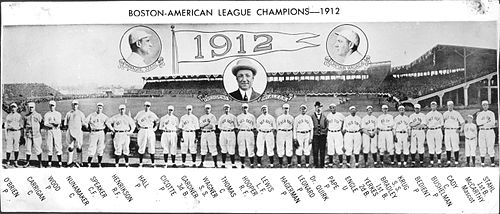| 1912 Boston Red Sox | ||
|---|---|---|
| World Series champions American League champions | ||
| League | American League | |
| Ballpark | Fenway Park | |
| City | Boston, Massachusetts | |
| Record | 105–47 (.691) | |
| League place | 1st | |
| Owners | John I. Taylor Jimmy McAleer | |
| Manager | Jake Stahl | |
| Stats | ESPN.com Baseball Reference | |
| ||
The 1912 Boston Red Sox season was the 12th season in the franchise's Major League Baseball history. This was the first year that the team played its home games at Fenway Park. The Red Sox finished first in the American League (AL) with a record of 105 wins and 47 losses. The team set the franchise record for highest winning percentage (.691) in a season, which still stands; tied the franchise record for fewest losses in a season, originally set by the 1903 team; and set a franchise record for most wins, which was not surpassed until the 2018 club. [1]
Contents
- Offseason
- Transactions
- Regular season
- Transactions 2
- Season standings
- Record vs. opponents
- Opening Day lineup
- Roster
- Player stats
- Batting
- Pitching
- Awards and honors
- League top five finishers
- World Series
- See also
- References
- Further reading
- External links
The team then faced the National League (NL) champion New York Giants in the 1912 World Series, which the Red Sox won in eight games to capture the franchise's second World Series. One of the deciding plays in the World Series was a muffed fly ball by Giants outfielder Fred Snodgrass, which became known as the "$30,000 muff" in reference to the prize money for the winning team. [2]
Behind center fielder Tris Speaker and pitcher Smoky Joe Wood, the Red Sox led the league in runs scored and fewest runs allowed. Speaker was third in batting and was voted league Most Valuable Player. Wood won 34 games, including a record 16 in a row. Although the pitching staff was satisfactory, the only star pitcher was Wood, while the only star in the starting lineup was Speaker. Little-known third baseman Larry Gardner was the next best hitter, while future Hall of Famer Harry Hooper had a poor offensive season.

